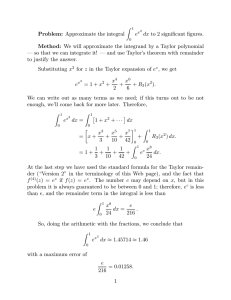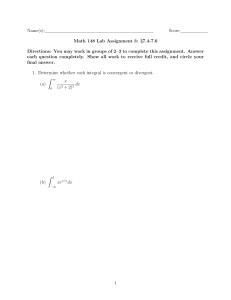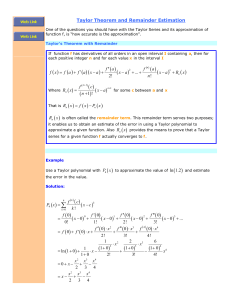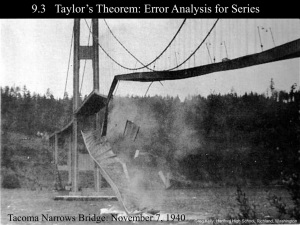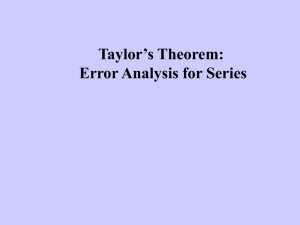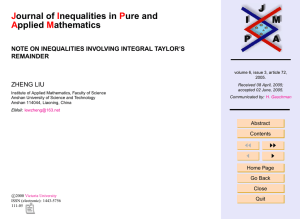J I P A
advertisement
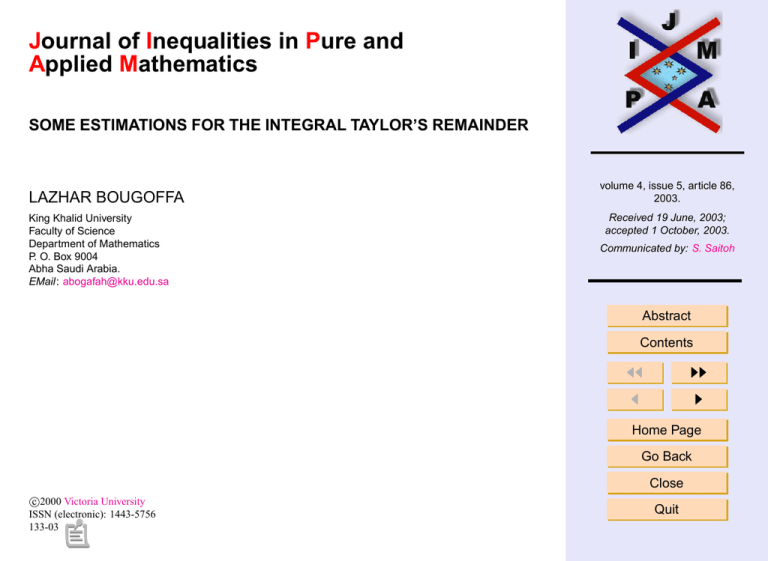
Journal of Inequalities in Pure and Applied Mathematics SOME ESTIMATIONS FOR THE INTEGRAL TAYLOR’S REMAINDER LAZHAR BOUGOFFA King Khalid University Faculty of Science Department of Mathematics P. O. Box 9004 Abha Saudi Arabia. EMail: abogafah@kku.edu.sa volume 4, issue 5, article 86, 2003. Received 19 June, 2003; accepted 1 October, 2003. Communicated by: S. Saitoh Abstract Contents JJ J II I Home Page Go Back Close c 2000 Victoria University ISSN (electronic): 1443-5756 133-03 Quit Abstract In this paper, using Leibnitz’s formula and pre-Grüss inequality we prove some inequalities involving Taylor’s remainder. 2000 Mathematics Subject Classification: 26D15 Key words: Taylor’s remainder, Leibnitz’s formula, Pre-Grüss inequality. Some Estimations for the Integral Taylor’s Remainder Contents 1 Introduction . . . . . . . . . . . . . . . . . . . . . . . . . . . . . . . . . . . . . . . . . 2 Results Based on the Leibnitz’s Formula . . . . . . . . . . . . . . . . . 3 Results based on the Grüss Type inequality . . . . . . . . . . . . . . . References 3 5 7 Lazhar Bougoffa Title Page Contents JJ J II I Go Back Close Quit Page 2 of 9 J. Ineq. Pure and Appl. Math. 4(5) Art. 86, 2003 http://jipam.vu.edu.au 1. Introduction Recently, H. Gauchman ([1] – [2]) derived new types of inequalities involving Taylor’s remainder. In this paper, we apply Leibnitz’s formula and pre-Grüss inequality [3] to create several integral inequalities involving Taylor’s remainder. The present work may be considered as an continuation of the results obtained in [1] – [2]. Let Rn,f (c, x) and rn,f (a, b) denote the nth Taylor’s remainder of function f with center c, and the integral Taylor’s remainder, respectively, i.e. Rn,f (c, x) = f (x) − n X f (n) (c) k=0 and Z rn,f (a, b) = a b n! Some Estimations for the Integral Taylor’s Remainder Lazhar Bougoffa (x − c)k , (b − x)n (n+1) f (x)dx. n! Lemma 1.1. Let f be a function defined on [a, b]. Assume that f ∈ C n+1 ([a, b]). Then, Z b Z b (b − x)n+1 (n+1) (1.1) f (x)dx, Rn,f (a, x)dx = (n + 1)! a a Z b Z b (x − a)n+1 (n+1) n+1 (1.2) (−1) Rn,f (b, x)dx = f (x)dx. (n + 1)! a a Title Page Contents JJ J II I Go Back Close Quit Page 3 of 9 J. Ineq. Pure and Appl. Math. 4(5) Art. 86, 2003 Proof. See [1]. http://jipam.vu.edu.au Lemma 1.2. Let f be a function defined on [a, b]. Assume that f ∈ C n+1 ([a, b]). Then (1.3) rn,f (a, b) = f (b) − f (a) − (b − a)f (1) (a) − · · · − (b − a)n (n) f (a). n! Some Estimations for the Integral Taylor’s Remainder Lazhar Bougoffa Title Page Contents JJ J II I Go Back Close Quit Page 4 of 9 J. Ineq. Pure and Appl. Math. 4(5) Art. 86, 2003 http://jipam.vu.edu.au 2. Results Based on the Leibnitz’s Formula We prove the following theorem based on the Leibnitz’s formula. Theorem 2.1. Let f be a function defined on [a, b]. Assume that f ∈ C n+1 ([a, b]). Then p p−1 X X (n−k) (b − a)n−k+1 k f (2.1) Cp−1 (a) , (−1)k Cpk Rn−k,f (a, x) ≤ (n − k + 1)! k=0 k=0 p p−1 X X (n−k) (b − a)n−k+1 k k (2.2) Cp Rn−k,f (b, x) ≤ Cp−1 f (b) , (n − k + 1)! k=0 k=0 where Cpk = p! . (p−k)!k! Some Estimations for the Integral Taylor’s Remainder Lazhar Bougoffa Title Page Proof. We apply the following Leibnitz’s formula Contents (F G)(p) = F (p) G + Cp1 F (p−1) G(1) + · · · + Cpp−1 F (1) G(p−1) + F G(p) , provided the functions F, G ∈ C p ([a, b]). n+1 Let F (x) = f (n−p+1) (x), G(x) = (b−x) . Then (n+1)! JJ J II I Go Back Close n+1 f (n−p+1) (x) (b − x) (n + 1)! p (p) = X k=0 n−k+1 (−1)k Cpk f (n−k+1) (x) (b − x) . (n − k + 1)! Integrating both sides of the preceding equation with respect to x from a to b Quit Page 5 of 9 J. Ineq. Pure and Appl. Math. 4(5) Art. 86, 2003 http://jipam.vu.edu.au gives us " (b − x)n+1 (n−p+1) f (x) (n + 1)! (p−1) #x=b x=a p = X k (−1) Cpk b Z f (n−k+1) (x) a k=0 (b − x)n−k+1 dx. (n − k + 1)! Rb The integral on the right is a Rn−k,f (a, x)dx,and to evaluate the term on the left hand side, we must again apply Leibnitz’s formula, obtaining Some Estimations for the Integral Taylor’s Remainder Lazhar Bougoffa − p−1 X p k (−1)k Cp−1 f (n−k) (a) k=0 (b − a)n−k+1 X = (−1)k Cpk (n − k + 1)! k=0 Z b Rn−k,f (a, x)dx. a Consequently, p p−1 X X (n−k) (b − a)n−k+1 k k k f Cp−1 (a) , (−1) Cp Rn−k,f (a, x) ≤ (n − k + 1)! k=0 k=0 which proves (2.1). To prove (2.2), set F (x) = f (n−p+1) (x), G(x) = in the proof of (2.1). Title Page Contents JJ J II I Go Back Close (x−a)n+1 , (n+1)! and continue as Quit Page 6 of 9 J. Ineq. Pure and Appl. Math. 4(5) Art. 86, 2003 http://jipam.vu.edu.au 3. Results based on the Grüss Type inequality We prove the following theorem based on the pre-Grüss inequality. Theorem 3.1. Let f (x) be a function defined on [a, b] such that f ∈ C n+1 ([a, b]) and m ≤ f (n+1) (x) ≤ M for each x ∈ [a, b], where m and M are constants. Then (n) (n) f (b) − f (a) n (3.1) rn,f (a, b) − (b − a) (n + 1)! n (b − a)n+1 M −m · . ≤ 1 · 2 (n + 1)! (2n + 1) 2 Some Estimations for the Integral Taylor’s Remainder Lazhar Bougoffa Proof. We apply the following pre-Grüss inequality [3] Title Page T (F, G)2 ≤ T (F, F ) · T (G, G), Contents (3.2) JJ J where F, G ∈ L2 (a, b) and T (F, G) is the Chebyshev’s functional: 1 T (F, G) = b−a Z a b 1 F (x)G(x)dx − b−a Z a b 1 F (x)dx · b−a Z b G(x)dx. II I Go Back a Close If there exists constants m, M ∈ R such that m ≤ F (x) ≤ M on [a, b], specially, we have [3] (M − m)2 T (F, F ) ≤ 4 Quit Page 7 of 9 J. Ineq. Pure and Appl. Math. 4(5) Art. 86, 2003 http://jipam.vu.edu.au and (3.3) Z b Z b Z b 1 1 1 F (x)G(x)dx − F (x)dx · G(x)dx b − a b−a a b−a a a " 2 # 12 Z b Z b 1 1 1 G2 (x)dx − G(x)dx . ≤ (M − m) 2 b−a a b−a a In formula (3.3) replacing F (x) by f (n+1) (x), and G(x) by (3.1). (b−x)n , n! we obtain 0 Remark 3.1. It is possible to define the similar expression rn,f (a, b) by 0 rn,f (a, b) Z = a b (x − a)n (n+1) f (x)dx. n! In exactly the same way as inequality (3.1) was obtained, one can obtain the following inequality (3.4) (n) (n) 0 f (b) − f (a) n rn,f (a, b) − (b − a) (n + 1)! n M −m (b − a)n+1 ≤ · · . 1 2 (n + 1)! (2n + 1) 2 Some Estimations for the Integral Taylor’s Remainder Lazhar Bougoffa Title Page Contents JJ J II I Go Back Close Quit Page 8 of 9 J. Ineq. Pure and Appl. Math. 4(5) Art. 86, 2003 http://jipam.vu.edu.au References [1] H. GAUCHMAN, Some integral inequalities involving Taylor’s remainder. II, J. Inequal. Pure and Appl. Math., 4(1) (2003), Art. 1. [ONLINE: http: //jipam.vu.edu.au/v4n1/011_02.html]. [2] H. GAUCHMAN, Some integral inequalities involving Taylor’s remainder, J. Inequal. Pure and Appl. Math., 3(2) (2002), Art. 26. [ONLINE: http: //jipam.vu.edu.au/v3n2/068_01.html]. [3] N. UJEVIĆ, A Generalization of the pre-Grüss inequality and applications to some quadrature formulae, J. Inequal. Pure and Appl. Math., 3(1) (2002), Art. 13. [ONLINE: http://jipam.vu.edu.au/v3n1/ 038_01.html]. Some Estimations for the Integral Taylor’s Remainder Lazhar Bougoffa Title Page Contents JJ J II I Go Back Close Quit Page 9 of 9 J. Ineq. Pure and Appl. Math. 4(5) Art. 86, 2003 http://jipam.vu.edu.au
